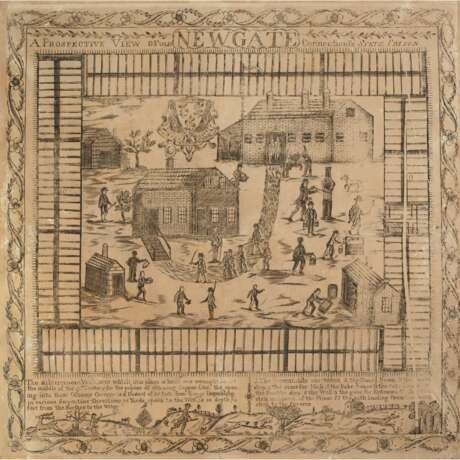ID 696273
Los 339 | A Prospective View of Old Newgate Connecticut's State Prison
Schätzwert
$ 4 000 – 6 000
Richard Brunton, 1870
[BRUNTON, Richard (1749-1832)] A Prospective View of Old Newgate Connecticut's State Prison. [Boston, 1870].
An exceedingly rare copperplate engraving attributed to an inmate at Connecticut's State Prison. A wonderfully detailed view of the notorious prison that built atop the site of the Simsbury Copper Mine in East Granby, Connecticut which was formally used as a camp for British prisoners of war during the War of Independence before it was repurposed to house common criminals. The view shows the several buildings that made up the prison with a numbered key below the image including the "Commandants apartment" as well as the guard house, workshops, the bakery, blacksmith's shop, the iron fence surrounding the complex as well as "the path leading from the work shop to the Caverns[.]" Various guards and inmates also populate the scene including two Black inmates. One inmate is lashed to a whipping pole while several others are marched at bayonet-point toward the building built atop the mine shaft.
Born in Birmingham, where he apprenticed as an engraver, Richard Brunton came to America as a solider-- specifically, a member of 38th Regiment of Foot which served in the Lexington and Concord expedition in 1775. Brunton continued with the British Army through the campaigns of 1776, 1777 and 1778 until he deserted at Verplanck's point in 1779. Later the same year he married a New England woman and attempted to ply his trade as an artist and engraver—first in Boston and then in Providence but with little success. Unable to make an honest living, Brunton turned to counterfeiting, first with currency for which he was arrested in 1795, but not convicted, and then with coins in 1799. The latter offence landed him in New-Gate Prison. Albert C. Bates attributed the engraving to Brunton based on two paintings that Brunton made of the prison's superintendent and his wife during his two-year incarceration as well as the fact that the engraving features an iron fence which was replaced in 1802 with a stone wall (See Bates, An Early Connecticut Engraver and His Work, 1906. pp. 31-32). For a full treatment of Brunton's life and work, See Deborah M. Child, Soldier, Engraver, Forger: Richard Brunton's Life on the Fringe in America's New Republic (2015).
Rare. Bates identified only three extant copies of this engraving dating from 1799 but notes that an additional six or eight were struck in Boston in 1870 after which the plate was destroyed. The Connecticut Historical Society holds both the original 1799 strike as well as the 1870 restrike, and this exmaple appears to be consistent with the latter. The later date notwithstanding, this print remains a great rarity. We are grateful to Andrea Rapacz, Director of Collections at the Connecticut Historical Society and historian Deborah M. Child for theirassistance with our research.
Copperplate engraving. 21 7⁄16 x 21 9⁄16 in. (543 x 548mm). Hinged at all four corners and backed with archival tissue (some surface abrasions, vertical crease affecting image and several words of text, light even toning, some weak folds repaired, a few minor marginal chips).
| Kategorie: | Kunstdrucke |
|---|
| Kategorie: | Kunstdrucke |
|---|
| Adresse der Versteigerung |
CHRISTIE'S 20 Rockefeller Plaza 10020 New York Vereinigten Staaten | ||||||||||||||
|---|---|---|---|---|---|---|---|---|---|---|---|---|---|---|---|
| Vorschau |
| ||||||||||||||
| Telefon | +1 212 636 2000 | ||||||||||||||
| Fax | +1 212 636 4930 | ||||||||||||||
| Nutzungsbedingungen | Nutzungsbedingungen | ||||||||||||||
| Versand |
Postdienst Kurierdienst Selbstabholung | ||||||||||||||
| Zahlungsarten |
Banküberweisung | ||||||||||||||
| Geschäftszeiten | Geschäftszeiten
|



